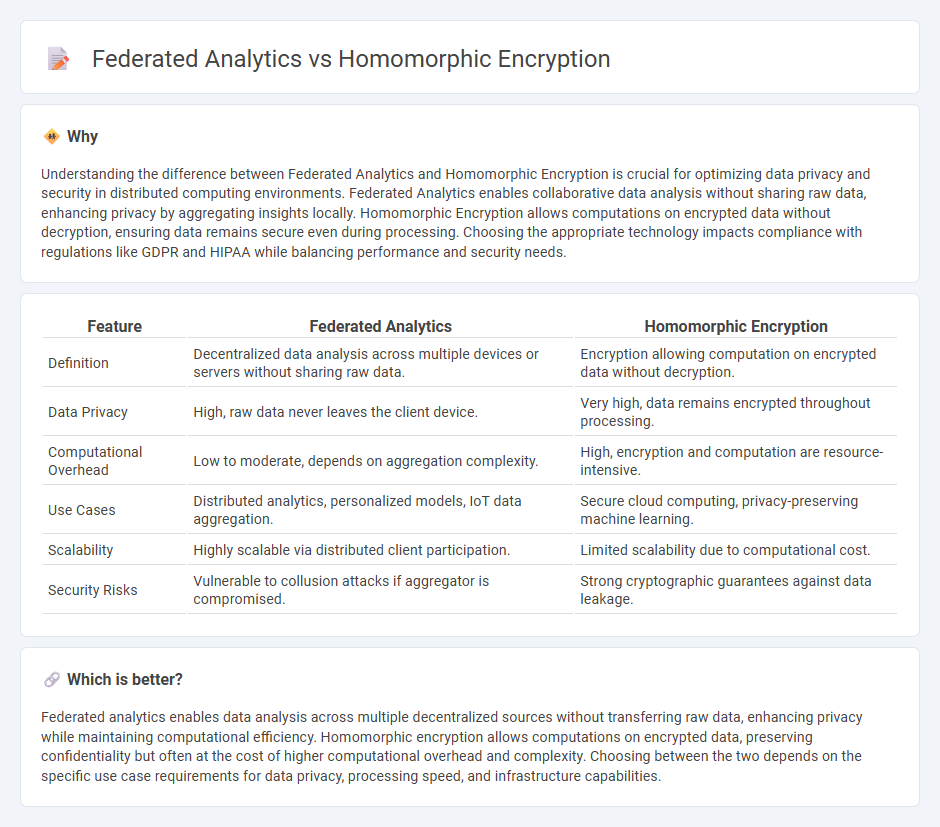
Federated analytics enables collaborative data analysis across multiple decentralized devices while preserving data privacy by processing information locally and sharing only aggregated results. Homomorphic encryption allows computations to be performed directly on encrypted data, ensuring data confidentiality even during processing on untrusted platforms. Explore how these cutting-edge technologies transform privacy-preserving data analytics in various industries.
Why it is important
Understanding the difference between Federated Analytics and Homomorphic Encryption is crucial for optimizing data privacy and security in distributed computing environments. Federated Analytics enables collaborative data analysis without sharing raw data, enhancing privacy by aggregating insights locally. Homomorphic Encryption allows computations on encrypted data without decryption, ensuring data remains secure even during processing. Choosing the appropriate technology impacts compliance with regulations like GDPR and HIPAA while balancing performance and security needs.
Comparison Table
| Feature | Federated Analytics | Homomorphic Encryption |
|---|---|---|
| Definition | Decentralized data analysis across multiple devices or servers without sharing raw data. | Encryption allowing computation on encrypted data without decryption. |
| Data Privacy | High, raw data never leaves the client device. | Very high, data remains encrypted throughout processing. |
| Computational Overhead | Low to moderate, depends on aggregation complexity. | High, encryption and computation are resource-intensive. |
| Use Cases | Distributed analytics, personalized models, IoT data aggregation. | Secure cloud computing, privacy-preserving machine learning. |
| Scalability | Highly scalable via distributed client participation. | Limited scalability due to computational cost. |
| Security Risks | Vulnerable to collusion attacks if aggregator is compromised. | Strong cryptographic guarantees against data leakage. |
Which is better?
Federated analytics enables data analysis across multiple decentralized sources without transferring raw data, enhancing privacy while maintaining computational efficiency. Homomorphic encryption allows computations on encrypted data, preserving confidentiality but often at the cost of higher computational overhead and complexity. Choosing between the two depends on the specific use case requirements for data privacy, processing speed, and infrastructure capabilities.
Connection
Federated analytics enables secure data analysis across distributed sources without centralizing raw data, preserving privacy in collaborative environments. Homomorphic encryption allows computations to be performed directly on encrypted data, ensuring that sensitive information remains confidential during processing. The integration of homomorphic encryption in federated analytics enhances data privacy by enabling encrypted multi-party computations, facilitating secure and privacy-preserving insights from decentralized data sets.
Key Terms
Data Privacy
Homomorphic encryption enables computations on encrypted data without revealing sensitive information, ensuring maximum data privacy during processing. Federated analytics allows collaborative data analysis by aggregating insights from decentralized data sources without transferring raw data, thereby enhancing privacy preservation. Explore the differences and benefits of these privacy-first technologies to strengthen your data security strategy.
Trust Model
Homomorphic encryption enables computations on encrypted data without exposing raw information, relying on cryptographic trust to protect data privacy. Federated analytics distributes data processing across multiple devices or servers, emphasizing decentralized trust and control by keeping data local. Explore how each trust model impacts security and efficiency in privacy-preserving data analysis.
Source and External Links
Homomorphic encryption - A form of encryption enabling computations on encrypted data without decryption, including various types such as partially, somewhat, leveled fully, and fully homomorphic encryption, with fully homomorphic encryption supporting arbitrary-depth computations on ciphertexts.
What Is Homomorphic Encryption? - Explains homomorphic encryption types and applications, highlighting that fully homomorphic encryption allows unlimited computations on encrypted data but is still computationally expensive for many use cases.
Combining Machine Learning and Homomorphic Encryption - Describes Apple's implementation of homomorphic encryption (using the BFV scheme) for secure machine learning computations on encrypted data, supporting privacy-preserving operations with strong post-quantum security.
 dowidth.com
dowidth.com